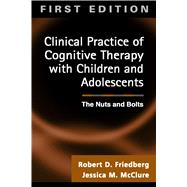An ideal teaching text or practitioner reference, this book offers a complete introduction to doing cognitive therapy with children and adolescents. A systematic yet flexible approach to case conceptualization and treatment planning is presented. The authors review the essentials of orienting children and families to cognitive therapy, structuring each session, and implementing commonly used cognitive and behavioral techniques. Concluding chapters describe strategies for addressing specific clinical problems: depression, anxiety, and disruptive behavior.








